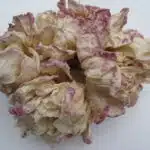The common lilac (Syringa vulgaris) is a popular ornamental shrub known for its fragrant and beautiful flowers. This deciduous shrub belongs to the olive family and can grow up to 20 feet tall, producing clusters of pink, purple, white or blue flowers in spring. Growing common lilacs can be a rewarding experience for gardeners as they add beauty and fragrance to any garden or landscape.
When it comes to growing common lilacs, there are several factors that need to be considered. These include the right soil conditions, proper pruning techniques, and appropriate watering and fertilization methods. In this article, we will discuss some tips for growing common lilacs in your garden or landscape. By following these tips, you can ensure that your lilacs will thrive and provide years of enjoyment for you and your loved ones.
Understanding The Common Lilac Plant
As the saying goes, “April showers bring May flowers,” and for lovers of lilacs, this means blooms bursting with sweet fragrance and vibrant colors. The common lilac plant (syringa vulgaris) is a deciduous shrub that can grow up to 20 feet tall and equally wide. It is native to southeastern Europe and has been cultivated in North America since the 17th century.
To successfully cultivate common lilacs, one must understand their growth stages. During the first year of planting, the shrub will spend its energy establishing a root system. In the second year, it will begin to develop new stems and leaves from buds on old wood or suckers emerging from roots. By the third year, flowers may appear, but it may take up to five years for established plants to bloom consistently.
Pruning techniques are crucial in maintaining a healthy and attractive common lilac plant. Prune annually after blooming by removing dead or diseased wood and any branches that cross or rub against each other. This will promote air circulation within the plant and encourage new growth for next season’s blooms. Avoid cutting back more than one-third of the shrub’s total height in any given year, as this can stunt growth and reduce flowering potential.
Choosing The Right Location For Your Lilacs
After understanding the common lilac plant, choosing the right location for your lilacs is crucial for their growth and development. The ideal climate for common lilacs is cool to temperate, with winters that are cold enough to provide a sufficient dormancy period. It is also important to consider sun exposure when selecting a location for your lilacs.
Common lilacs thrive in areas with full sun exposure, which means at least six hours of direct sunlight daily. They can tolerate partial shade but will not bloom as abundantly as those planted in full sun. When planting your lilacs, make sure they are not shaded by nearby trees or buildings.
In summary, selecting the right location for your common lilacs requires consideration of both climate and sun exposure. These factors play a vital role in ensuring that your plants grow and blossom beautifully. In the next section, we will delve into the soil requirements for common lilacs to further enhance their growth and overall health.
Soil Requirements For Common Lilacs
Soil pH is an important factor when considering soil requirements for common lilacs, as lilacs prefer soils with a pH between 6.0 and 7.0. It is also essential for soil drainage to be adequate, as lilacs are sensitive to wet soils and can suffer from root rot. In order to ensure that common lilacs receive enough plant nutrition, it is important to add compost and other organic matter to the soil prior to planting. Furthermore, adding an appropriate fertilizer to the soil at specific intervals throughout the growing season can help to ensure an overall healthy plant. Finally, it is important to monitor the soil pH and drainage levels regularly to ensure that the soil conditions are suitable for common lilacs.
Soil Ph
In order to successfully grow common lilacs (syringa vulgaris), it is important to pay attention to the soil requirements of this plant. One critical aspect of soil requirements for common lilacs is the pH level. Common lilacs prefer a slightly acidic soil with a pH level between 6.0 and 7.0. However, if your soil is not within this range, adjusting soil pH may be necessary.
The importance of soil testing cannot be overstated when it comes to determining whether or not you need to adjust your soil’s pH level. It is recommended that gardeners test their soil every three to five years. Soil testing kits are available at most garden centers and can give you an accurate reading of your soil’s pH level as well as nutrient levels. Once you know the current state of your soil, you can then take steps towards adjusting its pH level.
Adjusting soil pH can be done in several ways depending on the current state of your soil and what type of amendment is needed. For example, adding elemental sulfur can lower the pH level while adding lime can raise it. However, it is important to note that adjusting the pH level should be done gradually over time rather than all at once in order to avoid shocking the plant’s roots. By paying attention to the pH level of your soil and taking necessary steps towards adjusting it, you will ensure that your common lilacs thrive in a healthy environment for years to come.
Soil Drainage
As a horticulturalist, it is essential to understand the soil requirements of common lilacs (syringa vulgaris) in order to ensure their proper growth and development. While pH levels play a crucial role in meeting the plant’s needs, soil drainage is another important factor that must be taken into consideration. Common lilacs require well-draining soil to prevent waterlogging, which can lead to root rot and other diseases.
Improving drainage is crucial for ensuring healthy growth in common lilacs. The best way to do this is by ensuring that the soil has adequate amounts of organic matter, such as compost or peat moss. Organic matter helps to improve soil structure by increasing pore space, allowing for better air circulation and water absorption. Additionally, one may also consider adding sand or perlite into the soil mixture to help improve drainage further.
In conclusion, when it comes to the soil requirements for common lilacs, proper drainage plays a critical role in their overall health and development. By taking steps towards improving drainage through adding organic matter and other amendments, gardeners can create an ideal growing environment for their plants. With attention paid to both pH levels and drainage needs, gardeners can enjoy beautiful blooms from their common lilac bushes year after year.
Plant Nutrition
As horticulturalists, we aim to provide plants with the best possible growing conditions to ensure their optimal growth and development. While soil pH and drainage play critical roles in meeting the needs of common lilacs, plant nutrition is another significant factor that must be considered. Adequate plant nutrition is essential for promoting healthy growth, disease resistance, and optimal flowering.
The importance of proper plant nutrition cannot be overstated. Common lilacs require a balanced supply of nutrients such as nitrogen (N), phosphorus (P), and potassium (K), as well as trace elements such as iron (Fe) and manganese (Mn). Nutrient deficiencies can lead to stunted growth, yellowing leaves, and poor flowering. To avoid these issues, gardeners should consider using organic fertilizers or slow-release fertilizers that provide a steady supply of nutrients over time. It’s also essential to avoid over-fertilization, which can lead to excessive leaf growth at the expense of flowers.
In addition to providing adequate nutrients, horticulturalists can take several other steps to ensure proper plant nutrition for common lilacs. For instance, they can conduct soil tests regularly to monitor nutrient levels and adjust fertilizer applications accordingly. They can also incorporate organic matter into the soil annually to improve soil structure and nutrient availability. By paying attention to plant nutrition along with soil pH and drainage needs, we can create an ideal growing environment for common lilacs and enjoy their beautiful blooms year after year.
Fertilizing Your Lilacs For Optimal Growth
Ah, the sweet scent of lilacs in the air! What could be more delightful? But, as any horticulturalist will tell you, growing common lilac (syringa vulgaris) is not just about enjoying its fragrance. It requires proper care and attention to ensure optimal growth. In this section, we will discuss fertilizing your lilacs for optimal growth.
Fertilization is key to ensuring that your lilacs grow healthy and strong. Organic options are recommended because they provide a slow release of nutrients over time, which is ideal for the long-term health of your plant. Some good organic fertilizers include bone meal, blood meal, and fish emulsion. Apply these fertilizers in early spring before new growth appears and again in late fall after the leaves have fallen off.
Timing of application is critical when it comes to fertilizing your lilacs. Applying too much or at the wrong time can do more harm than good. Be sure to follow the manufacturer’s instructions carefully to avoid over-fertilizing or burning your plants. Generally, it’s best to fertilize once a year with organic options rather than using chemical fertilizers multiple times throughout the growing season.
Now that you know how to fertilize your common lilacs for optimal growth, it’s time to move on to watering techniques. Watering is just as important as fertilizing when it comes to keeping your plants healthy and happy. In the next section, we will discuss some tips for watering your common lilacs so that they thrive year after year.
Watering Techniques For Common Lilacs
After properly fertilizing your lilacs, it’s important to consider the watering techniques for optimal growth. Lilacs require deep watering, which means ensuring that the water reaches the root system. This can be done by using a soaker hose or drip irrigation system that will allow water to slowly penetrate into the soil. Deep watering encourages deeper root growth, making the plant more resilient during droughts.
Frequent watering is also essential for common lilacs, especially during hot summer months. However, it’s important not to overwater as this can cause root rot and other fungal diseases. A good rule of thumb is to water deeply once a week and adjust based on weather conditions. During periods of heavy rain, it may not be necessary to water at all.
Proper watering techniques are crucial in maintaining healthy lilac plants. In addition to deep and frequent watering, it’s important to ensure proper drainage and avoid getting water on the leaves as this can lead to powdery mildew. By following these guidelines, your common lilacs will thrive and produce beautiful blooms year after year.
Moving forward with caring for your common lilacs, pruning is an essential step in promoting healthy growth and keeping the plant looking attractive.
Pruning Your Lilacs For Healthy Growth
Pruning of common lilacs (Syringa vulgaris) should take place in late winter or early spring when the shrub is dormant. Proper pruning techniques should be employed to ensure healthy growth; this includes thinning out dense interior branches, removing dead, diseased, or damaged wood, and cutting back the previous year’s growth. Any branches that are growing too close together should also be pruned. Pruning should be done in a way that preserves the shrub’s natural shape and size, allowing for a natural flow of air and sunlight.
Pruning Time
When it comes to pruning techniques for common lilac, timing is everything. The best time to prune your lilacs is right after they have finished blooming in the spring. This allows enough time for new growth to mature and develop buds for next year’s blooms. Pruning at this time will also prevent the removal of any potential flower buds that may be forming during the summer.
It is important to note that pruning too late in the season can result in less vigorous growth and fewer blooms the following year. Waiting too long can also make it difficult to identify which branches need to be removed. As a horticulturalist, I recommend using sharp, clean tools when pruning your lilacs and avoiding any major cuts that could damage the overall structure of the plant.
In conclusion, properly timed pruning is essential for maintaining healthy growth and abundant blooms on your common lilac. By following these tips and techniques, you can ensure that your plants remain strong and vibrant year after year. Remember to always consider the best time to prune and use careful, precise cuts to protect the integrity of your lilac shrubs.
Pruning Techniques
Pruning is an essential aspect of maintaining the health and beauty of your common lilac. However, it’s important to understand the frequency at which pruning should be done to promote optimal growth. Pruning too often can result in stunted or weak growth, while not pruning enough can cause overcrowding and a lack of airflow. Therefore, it’s recommended to prune your lilacs every three to four years to remove any dead or diseased branches and promote new growth.
Timing is critical when it comes to pruning your common lilac. As mentioned earlier, the best time to prune your lilacs is right after they have finished blooming in the spring. This allows for new growth to mature and develop buds for next year’s blooms. Late pruning can result in less vigorous growth and fewer blooms the following year. It’s also important not to prune during the fall or winter months as this can lead to damage from freezing temperatures.
When it comes to pruning techniques, it’s crucial always to use sharp, clean tools that won’t cause any damage or harm the overall structure of your plant. The method of cutting should be at a 45-degree angle just above a bud facing outward from the center of the plant. This will ensure that new growth will branch out in a desirable direction rather than into other branches or towards the center of the shrub. Remember that proper timing and techniques will guarantee healthy growth and an abundance of blooms on your common lilac for years to come!
Propagating Common Lilacs
Lilac propagation techniques are fairly simple and can be done by either taking cuttings or layering. Taking cuttings is the most common way to propagate lilacs, and it involves taking a stem cutting from the parent plant during its dormant season. The cutting should be about 6 inches long, taken from a healthy stem, and stripped of its lower leaves.
Layering is another effective method for propagating common lilacs. This technique involves bending a lower branch down to the ground and making a small nick in the bark where it touches the soil. Then, cover the nick with soil and hold it in place with a rock or stake. Over time, new roots will form at the point where the nick was made, allowing you to separate the new plant from the parent once it has taken root.
When propagating common lilac cultivars, it’s important to keep in mind that some cultivars may not produce offspring that are identical to their parent plant. If you’re looking to propagate a particular cultivar of common lilac, consider taking cuttings instead of layering as this method will produce an exact clone of your desired plant.
Transition: Now that you know how to propagate common lilacs successfully, it’s important to also be aware of potential pests and diseases that can affect them. In the next section, we’ll discuss how to deal with these issues effectively without harming your plants or environment.
Dealing With Common Lilac Pests And Diseases
Having successfully propagated your common lilacs, it is crucial to ensure that they remain healthy and free from pests and diseases. Preventing infestations is a key element in maintaining the health of your lilac plants. One effective way to prevent infestations is by regularly inspecting your plants for signs of pest damage, such as chewed leaves or holes in the foliage. Another way to prevent infestations is by removing dead or damaged branches, which can attract pests.
Identifying diseases that commonly affect common lilacs is also important in maintaining their health. Powdery mildew is a common fungal disease that affects many varieties of lilacs, causing white powdery patches on the leaves and stems. To prevent powdery mildew, avoid overcrowding your plants and make sure they receive sufficient sunlight and air circulation. Leaf spot is another fungal disease that causes brown or black spots on the leaves. To prevent leaf spot, avoid overhead watering and remove infected plant debris.
By taking steps to prevent infestations and identifying diseases early on, you can keep your common lilacs healthy and thriving for years to come. In the next section, we will discuss choosing the right lilac varieties for your garden, which will help you create a beautiful display of these fragrant flowers in your outdoor space.
Choosing The Right Lilac Varieties For Your Garden
A successful lilac garden begins with choosing the best cultivars for your growing zone. Gardeners in cooler climates should look for varieties that are more cold-hardy, such as ‘Charles Joly’ or ‘Sensation’. Those in warmer areas should choose heat-tolerant cultivars like ‘California Rose’ or ‘Miss Kim’. By selecting the right type of lilac, you can ensure that your plants will thrive and produce an abundance of fragrant blooms.
When considering which lilac varieties to plant, it’s essential to keep your landscape design in mind. Some cultivars grow larger than others, which may not be suitable for smaller gardens. On the other hand, some compact varieties can be grown in containers or used as hedges. Additionally, various colors and bloom times can create a stunning visual display when planted together. The key is to select cultivars that complement each other while fitting within the overall aesthetic of your landscape.
Lastly, it’s crucial to consider how incorporating lilacs into your landscape design can benefit the environment. Lilacs are known to attract pollinators such as bees and butterflies, which play a vital role in our ecosystem. Additionally, their fragrant blooms provide a source of food for birds and other wildlife. By carefully selecting and placing lilacs throughout your garden, you can create a beautiful and sustainable habitat that benefits both you and the environment.
Incorporating Lilacs Into Your Landscape Design
After selecting the right lilac varieties for your garden, it’s time to incorporate them into your landscape design. Lilacs are versatile plants that can be used in many different ways to create stunning displays. One way to use lilacs is through color schemes. Lilacs come in a range of colors, including white, pink, and purple. When creating a color scheme with lilacs, consider pairing them with other plants that have complementary or contrasting colors.
Another way to incorporate lilacs into your landscape design is by pairing them with companion plants. Companion planting involves planting two or more types of plants together that benefit each other in some way. For example, planting lilacs with bee balm can help attract pollinators to your garden. Other companion plants for lilacs include daylilies, phlox, and alliums.
Incorporating lilacs into your landscape design can enhance the beauty of your garden while also providing benefits for other plants and pollinators. By using lilac color schemes and companion plants, you can create a cohesive and visually appealing display that will make your garden stand out. In the next section, we will discuss how to maintain lilacs in containers for those who may not have space for a full garden bed.
Maintaining Lilacs In Containers
As a horticulturalist, I understand the need for gardeners who live in small spaces to maintain their love for gardening. Growing lilacs in containers is one way to achieve this. However, the container selection plays a vital role in ensuring healthy growth and maximum blooms. Choose a container that is at least 18 inches in diameter and depth, with enough drainage holes to prevent waterlogging.
Watering frequency is another crucial factor when growing lilacs in containers. These plants prefer moist soil but do not tolerate standing water. Therefore, it is best to water them regularly but allow the soil to dry slightly between watering sessions. Overwatering can lead to root rot and other fungal diseases that can damage or kill the plant.
Growing lilacs in containers requires attention and care, but it is worth it for garden enthusiasts who want to enjoy these beautiful flowers even without a large yard. With proper container selection and watering techniques, you can create an ideal environment for your lilacs to thrive. In the subsequent section, we will explore how you can use your lilac blooms for cut flowers and fragrant bouquets without harming your plant’s health.
Using Lilacs For Cut Flowers And Fragrant Bouquets
Maintaining Lilacs in containers is a great way to enjoy the beauty and sweet fragrance of lilacs in small spaces or on patios. However, for those who want to incorporate lilac blooms into their home decor, using them for cut flowers and fragrant bouquets is an excellent option. Lilacs have a unique scent that fills the room with natural perfume, making them perfect for special occasions or just to bring joy into everyday life.
When creating a lilac bouquet arrangement, it’s essential to choose a variety of lilac colors and complementary foliage. White, pink, purple, and blue are popular choices that look stunning when combined together. Greens such as eucalyptus or fern can add texture and depth to the arrangement. When cutting lilacs for a bouquet, it’s best to do so early in the morning when they’re hydrated from the night dew. Cut stems at an angle under running water to prevent air bubbles from forming in the stem.
To extend the lilac bloom season beyond its typical two-week lifespan, there are a few tricks you can try. Deadheading spent blooms will encourage new growth and prolong blooming time. Additionally, adding mulch around the base of the plant will help retain moisture and regulate soil temperature during hot summer months. Finally, pruning your lilac bushes after they’ve finished blooming will promote healthy growth for next year’s blooms while keeping an aesthetically pleasing shape. With these tips, you can enjoy lilac blooms well beyond their typical short bloom window.
Extending The Lilac Bloom Season
The common lilac, with its delicate and fragrant flowers, is a favorite among gardeners. However, the bloom season for this plant is relatively short-lived, lasting only two to three weeks in late spring. To extend the bloom season of your common lilac, you can incorporate companion plants that bloom at different times throughout the growing season.
One example of a companion plant for common lilacs is peonies. Peonies are known to bloom later in the season and can provide a beautiful contrast to the early blooming lilacs. Additionally, planting annuals such as marigolds or zinnias near your lilacs can ensure color and interest throughout the summer months when your lilacs are no longer in bloom.
Timing of pruning also plays a crucial role in extending the bloom time of common lilacs. Pruning should be done immediately after flowering, before new growth begins to develop. This allows for maximum flower production during the next growing season. By incorporating companion plants and timing your pruning correctly, you can enjoy an extended period of beautiful blooms from your common lilac.
Transition: As important as it is to extend the blooming period of your common lilacs, it is just as important to care for them in preparation for winter dormancy.
Overwintering Common Lilacs
Common lilacs are hardy and can withstand cold temperatures. However, protecting branches from harsh winter weather is important to ensure the plant’s survival. One way to protect the branches is by wrapping them with burlap or other protective material. This will help prevent damage from ice, snow, and wind. It is essential to wrap the branches loosely so that air can circulate around them.
Mulching techniques can also help protect common lilacs during the winter months. Apply a layer of mulch around the base of the plant after the ground has frozen. This will help insulate the roots and retain moisture in the soil. Use organic materials such as wood chips, leaves, or straw as these provide better insulation than inorganic materials like rocks or gravel.
Properly overwintering common lilacs can go a long way in ensuring healthy growth and blooming come springtime. Protecting branches and utilizing mulching techniques are simple yet effective ways to safeguard your plants during colder months.
Moving forward, if you encounter any issues with your common lilac plants despite proper overwintering practices, there are a few troubleshooting steps you can take to address these problems.
Troubleshooting Common Lilac Problems
Did you know that common lilacs, also known as Syringa vulgaris, are one of the most popular shrubs in North America? This deciduous plant is loved for its fragrant and attractive flowers that bloom in late spring to early summer. However, caring for lilac shrubs can be challenging due to various pests and diseases that can cause damage. In this section, we will discuss some of the most common problems encountered when growing common lilacs and how to prevent them.
One of the main issues with lilac shrubs is powdery mildew. This fungal disease affects the leaves and stems of the plant, causing a white or gray powdery coating on the surface. To prevent powdery mildew, make sure your lilac shrub is planted in an area with good air circulation and receives plenty of sunlight. Additionally, avoid overhead watering, which can spread spores from infected plants. If your lilac does get infected with powdery mildew, prune off any affected leaves or branches immediately and dispose of them properly.
Another problem commonly encountered when growing common lilacs is bacterial blight. This disease causes wilting, yellowing, and browning of leaves, as well as black spots on stems and flowers. To prevent bacterial blight, avoid overhead watering and make sure your lilac is planted in well-drained soil. Pruning out any diseased branches or blooms can also help stop the spread of the bacteria.
To summarize, caring for lilac shrubs requires vigilance against pests and diseases such as powdery mildew and bacterial blight. By providing proper care including adequate sunlight exposure, good air circulation, proper watering practices, and prompt pruning of diseased parts you can ensure healthy growth for your beloved Syringa vulgaris plant.
| Common Lilac Problems | Causes | Prevention |
|---|---|---|
| Powdery Mildew | Fungal disease caused by high humidity and poor air circulation | Plant in well-drained soil with adequate sunlight and avoid overhead watering |
| Bacterial Blight | Caused by bacteria spread through water or pruning tools | Avoid overhead watering, prune out diseased parts, plant in well-drained soil with good air circulation |
| Aphids | Small insects that suck sap from leaves and shoots | Encourage natural predators like ladybugs, use insecticidal soap or neem oil |
| Lilac Borer | Larvae of clear-winged moths that bore into the wood of lilacs | Keep plants healthy to prevent infestation, prune out affected branches |
With proper care and attention, you can enjoy the beauty and fragrance of your common lilac shrub for years to come. Remember to regularly inspect your plant for signs of pests and diseases and take action promptly to prevent any further damage.
Frequently Asked Questions
How Long Does It Take For A Common Lilac To Bloom After Planting?
The common lilac (Syringa vulgaris) is a popular ornamental plant that produces fragrant and attractive flowers. The blooming period for common lilacs typically occurs in the late spring, around May or June, depending on the growing conditions. The time it takes for a common lilac to bloom after planting can vary depending on several factors, such as soil quality, sunlight exposure, watering frequency and pruning techniques. Generally, it takes about two to three years for a newly planted common lilac to reach maturity and produce its first blooms. To encourage optimal growth and blooming, it is recommended to provide well-draining soil, full sun exposure and regular pruning practices that remove dead or damaged branches.
Can Common Lilacs Grow In Containers All Year Round?
Growing common lilacs in containers all year round is a popular choice for many gardeners. However, container size and soil type are crucial factors to consider when attempting to maintain healthy growth and bloom production. The size of the container should be large enough to accommodate the root system without restricting its growth. A well-draining soil type that retains moisture is also essential for optimal plant development. As a horticulturalist, it is essential to recommend the appropriate container size and soil type for common lilac cultivation in containers. By doing so, we can ensure that our audience has the necessary information to grow healthy plants that serve their desire for beauty and enjoyment.
What Is The Best Way To Protect Common Lilacs From Deer And Other Wildlife?
Deer and other wildlife can pose a threat to common lilacs, as they may be attracted to the plant’s fragrant blooms. To protect against deer and other animals, there are several deterrent methods available. One option is the use of physical barriers such as fencing or netting around the plant. Another alternative is the application of deer repellent sprays, which can help deter deer from approaching the plant. Additionally, planting wildlife-friendly alternatives nearby such as native grasses or shrubs may help divert animals away from the lilac. It is important to note that while these methods may be effective, it is best to choose options that are environmentally friendly and safe for both the plant and surrounding ecosystem.
Can Common Lilacs Be Grown In A Tropical Climate?
While the common lilac (Syringa vulgaris) is well-known for its fragrant blooms and hardiness in temperate climates, it is not an ideal choice for tropical regions due to its preference for cooler temperatures. Lilac substitutes such as the Frangipani (Plumeria spp.) or the Singapore Rhododendron (Melastoma malabathricum) may be better suited for these warm environments. Alternatively, gardeners in tropical climates can also explore alternatives to lilacs such as the Butterfly Bush (Buddleja davidii) or the Cape Plumbago (Plumbago auriculata), both of which offer similar aesthetics and attract pollinators. As a horticulturalist, it is important to consider factors such as temperature and soil conditions when selecting plants for a particular climate, and to always seek out suitable alternatives that will thrive in their intended environment.
Are There Any Companion Plants That Are Known To Thrive Alongside Common Lilacs?
Companion plants are known to play a significant role in enhancing the growth and productivity of common lilacs (Syringa vulgaris). When selecting companion plants, it is essential to consider their soil requirements. In general, plants that prefer alkaline soils are often ideal companions for common lilacs. Some of the recommended companion plants include peonies, roses, and iris due to their preference for similar soil conditions. Peonies, for instance, have a deep root system that helps them absorb nutrients from the lower soil layers, which complements the shallow roots of common lilacs. Additionally, the colorful blooms of these companion plants can add visual interest to a garden alongside common lilacs’ attractive flowers. Overall, planting compatible companion plants alongside common lilacs is an effective way to boost their overall health and enhance the aesthetic appeal of a garden.
Conclusion
Common lilacs, also known as Syringa vulgaris, are a beautiful and fragrant addition to any garden. These deciduous shrubs can grow up to 20 feet tall and 15 feet wide, making them an excellent choice for creating a natural privacy screen or windbreak. When planting common lilacs, it is important to keep in mind several factors that will determine their growth and overall health.
Common lilacs typically take two to three years to bloom after planting. It is important to provide them with ample sunlight and well-draining soil during this time. Lilacs thrive in full sun, so be sure to plant them in an area that receives at least six hours of direct sunlight each day.
While common lilacs can be grown in containers, they may not thrive as well as they would in the ground. If you choose to grow them in pots, make sure they are large enough to accommodate their root system and that the soil is kept consistently moist.
Deer and other wildlife love common lilacs just as much as gardeners do. To protect your plants from being eaten or damaged by these animals, consider installing a physical barrier such as a fence or using repellent sprays.
Common lilacs are adapted to temperate climates and may struggle in tropical environments. If you live in a warmer climate but still want to enjoy the beauty of these shrubs, consider planting them near a building that provides shade or keeping them in a cool greenhouse.
Finally, there are several companion plants that work well alongside common lilacs. These include peonies, iris, daylilies, and phlox. Planting these flowers together can create a stunning display of color and fragrance throughout your garden.
In conclusion, growing common lilacs requires patience and attention to detail. By providing them with ample sunlight, well-draining soil, protection from wildlife, and suitable companions, you can enjoy the beauty of these fragrant shrubs for years to come. So, are you ready to add a touch of elegance and charm to your garden with common lilacs?
Image Credits
- “lilac flower – lila Flieder” by Bluecherry1408 (featured)





























